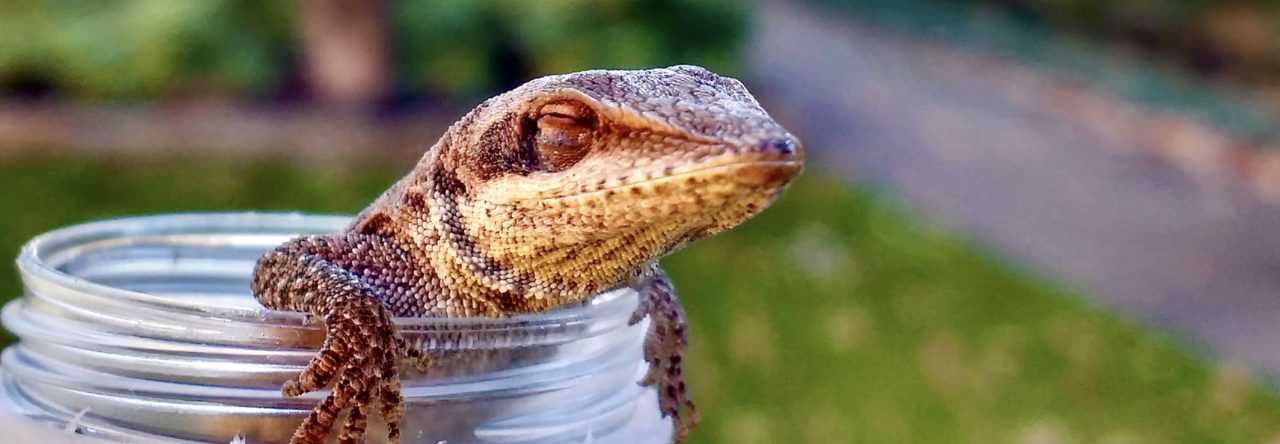Just in time for the American Society of Ichthyologists and Herpetologists meeting in New Orleans next week. From the New Orleans Advocate:
It flashed across the walkway like a lightning bolt, so fast that Bob Thomas had to do a double take. In that split second six months ago, he knew they had finally arrived.
“I’d been waiting for them to arrive in my neighborhood in Metairie. What I saw moved too fast for what we’re used to around here,” said Thomas, a herpetologist who taught at Loyola University and served as the founding director of the Louisiana Nature Center.
“It could only be one thing: a brown anole, Anolis sagrei.”
You’ve seen them — the speckled brown lizards that come out of nowhere and streak across the sidewalks. They travel in hordes — tiny, large and everything in between. Careful! You’re liable to step on them if you don’t pay attention.
Thomas’ neighborhood is far from being the first to experience an invasion of brown lizards. But where did they come from? Why are they so plentiful?
“Brown anoles are an invasive species, not native to the United States,” said David Heckard, curator of reptiles and amphibians at the Audubon Institute. “They are natives to Cuba and the Bahamas and first appeared in the U.S. in Florida. From Florida, they’ve been slowly expanding their range across the Gulf Coast. They’re aggressive and competitive and have even been spotted in Taiwan. They hitch rides on plants and are spread inadvertently by plant nurseries.”
The brown anole looks a lot different than the sleek green lizards we grew up with here in New Orleans (Anolis carolinensis). Generally, A. sagrei has a more compact physique and a shorter skull. A prominent hump appears where muscles attach at the back of the skull. When the brown anole extends its orange and red dewlap (the skin flap below its chin), it looks ferocious, indeed.
By contrast, the green anole looks far friendlier, even when its rosy-hued dewlap is extended. Native to the southeastern parts of the United States (although DNA studies suggest they originated in Cuba and came here a couple of million years ago), green anoles range as far north as North Carolina and as far west as Austin, Texas. They have delicately shaped heads and long, lean bodies. They were once plentiful in New Orleans, but sightings are becoming rare.
So, are the brown anoles killing off the green anoles, fighting over territory and winning? Consuming the green anole’s food supply?
“The theory is that the brown anoles are displacing the green anoles but not necessarily replacing them,” Heckard explained. “It’s believed that green anoles are more arboreal than brown anoles, which are more terrestrial. So, green anoles are being pushed to higher elevations — up into trees and the like. It may seem as though there are fewer of them, but they’re present — you just can’t see them hiding in the leaves and up in trees.”
Simon Lailvaux, a professor in UNO’s department of biological sciences, has studied anoles since working on his doctorate and supports the displacement theory.
“In the Caribbean, where there are dozens of species of lizards, they have learned to partition the habitat and have evolved to live in a specific part of it,” Lailvaux explained. “Green anoles there are trunk/crown inhabitants, whereas brown anoles are trunk/ground inhabitants. Over the millions of years that green anoles have been in the United States, they evolved to be able to occupy the ground because they didn’t have any competition for it. So, the relatively recent invasion of brown anoles has simply forced them back up into trees where they originally lived.”
Are we sure about that? Is anybody counting?
“How can you count green lizards way up on tree trunks and in the leaves at the crowns of trees?” answered Lailvaux. “You can’t.”
According to all three scientists, both types of anoles eat the same things: insects and other invertebrates. There are plenty of those to go around here, so it’s improbable that the green anole’s food supply is in jeopardy. Luckily for the green anoles, they may have a significant competitive advantage over the invaders.
“Brown anoles are cold sensitive and can survive only in a limited temperature range. That means the population of brown anoles crashes when we get a hard freeze, and it takes forever for their numbers to recover,” Lailvaux said. “The green anole, on the other hand, has evolved to be able to withstand lower temperatures, so they won’t be bothered by a freeze. We’re seeing, though, that it is taking less and less time after a freeze for the brown anoles to recover, which means they’re already beginning to adapt.”
The mild winters of the past few years may account for the explosion in the visibility of the brown anoles. But if A. carolinensis is being replaced (not merely vertically displaced) by A. sagrei, it would be a case of a native species dying out because an invasive species outcompetes it. Should we be looking into how to reverse that trend?
“The green anole may be a nostalgic favorite, but we don’t know yet what impact the proliferation of the brown anole will have on it or on other species. The sense is, however, that it won’t be wonderful,” Thomas said.
We know too well what an invasive species can do: Witness the nutria. By consuming the marshes, the animals not only reduced storm surge protection for our area but caused the demise of other species that called the marshes home, Thomas pointed out. Without further study, there’s no way to predict if the success of the brown anole could be similarly dire for the green anole and for biodiversity.













